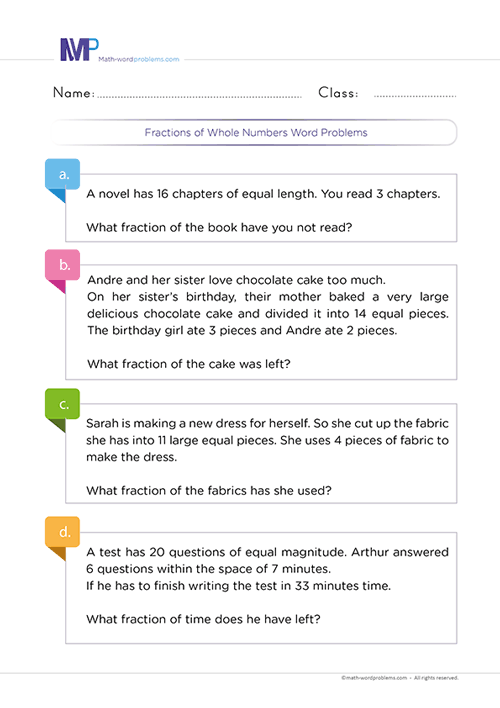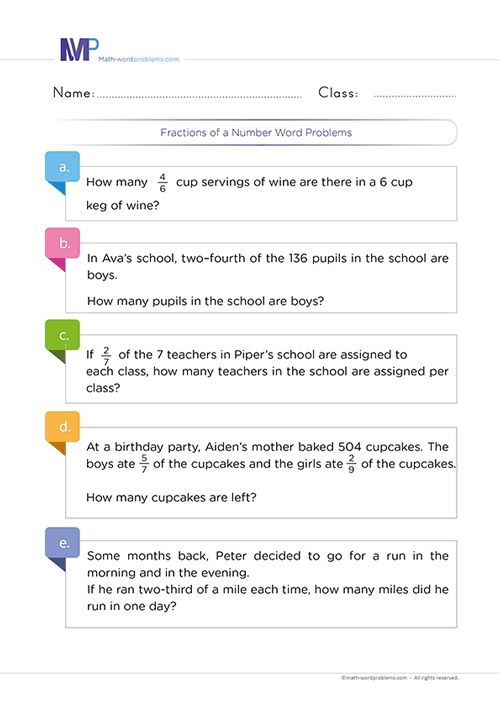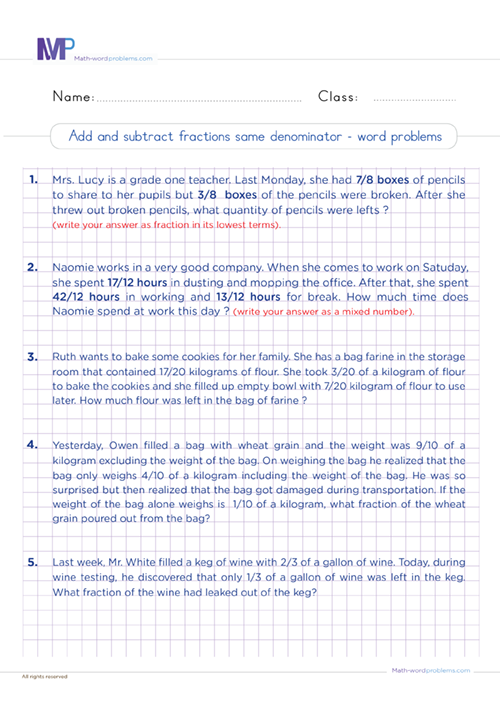 How to solve fractions of a whole word problem
How to solve fractions of a whole word problem
Do your kids need help on how to solve fractions of a whole word problem? You are in the right place! Hopefully, we will inspire them with our to solve fraction problems accurately.
Also, our reason for designing this powerful step-by-step guide is to help kids tackle all challenging word problems on fractions of a whole.
Steps to solve fractions of a whole word problems
We encourage you to quickly go through these steps to solve fractions of a whole word problem and gain everlasting fraction-solving experience. You will discover amusing techniques and approaches for solving any word problem on fractions of a whole.
For this reason, we will include some explicit examples to help explain how straightforward these steps work.
Step 1: IDENTIFY THE PROBLEM
To identify the problem, begin by finding out the situation that the problem wants you to solve. For instance, what you are looking for. You will discover this by identifying the most important keywords in the word problem.
- For instance, the only common keyword you need to look out for in fractions of a whole is “What fraction of” and whether the word problem consists of a part and a whole.
Note: One key Element for learners to understand is that they should not always rely on keywords alone. That is to say; the same keyword can have different meanings in different word problems.
For this reason, we reiterate on the importance of reading the question very carefully to understand the situation that the word problem is describing, then figure out exactly which operation to use
Step 2: STRATEGIZE OR GATHER RELEVANT INFORMATION
How will you solve or tackle the problem?
To grasp fractions of a whole quickly, you’ll need to understand some basic language used in fractions, like:
- Part, also known as the numerator, is the top number in a fraction. The numerator tells us how many pieces we are dealing with.
- The whole, also known as the denominator, is the bottom of a fraction. The denominator describes the size of the pieces.
After knowing what the part (numerator) and the whole (denominator) will be, construct short sentences to represent the given word problem.
Step 3: CREATE THE EQUATION
In step 3, you will write down a numerical expression to represent the information in the word problem. Use “/” to separate the numerator from the denominator.
Step 4: PROVIDE A SOLUTION
From step 3 above, you will simplify the fraction if need be. In addition to this, always recall the unit of measurement.
Step 5: CHECK YOUR WORK
Finally, check if your answer makes sense. For instance, estimate the answer and see if it is close to what you expected. However, if the answer is not what you expected, go back to step one and start all over again.
Examples on how to solve fractions of a whole word problems
Example one
Step 1: You see that the important numbers here are 17, which is the whole, and 2, which is the part. The keyword found in the word problem is “what fraction of. “
Step 2: Now, how will you solve the problem? The situation the problem describes and the keyword(s) found in the word problem show that it is a fraction of a whole word problem. So, you have to make use of the “part,” “/,” and the “whole.”
Furthermore, after knowing what the part (numerator) and the whole (denominator) will be, form short sentences to represent the given word problem, as shown below.
- Number of chapters you have read = 2
- Total number of chapters the novel has = 17.
- Therefore, the fraction of the novel you have to read = the number of chapters you have read as the numerator (part), and the total number of chapters the novel has as the denominator (whole).
Step 3:Write down a numerical fraction to represent the bolded statement in step 2 above. Use “/” to separate the numerator from the denominator.
Step 4: From step 3 above, simplify the fraction if necessary. In addition to this, always recall to include the unit of measurement.
So, you have read
Step 5: Finally, check if your answer makes sense. For instance, estimate the answer and see if it is close to what you expected. However, if the answer is not what you expected, go back to step one and start all over again.
Example Two
Step 1: You see that the important numbers here are 8, which is the whole, and 4, which is the part. The keyword found in the word problem is “what fraction of.
Step 2: Now, how will you solve the problem? The situation the problem describes and the keyword(s) found in the word problem show that it is a fraction of a whole word problem. So, you have to make use of the “part,” “/,” and the “whole.”
But you have to note what is being asked in the question.
The question is, “what fraction of the fabric has she NOT used?”
After knowing what the part (numerator) and the whole (denominator) will be, create short sentences to represent the given word problem, as shown below.
- Number of pieces of fabric she used to make the dress = 4
- Total number of pieces of fabric she cut up the fabrics into = 8
- Therefore, the fraction of the fabric she used = the number of pieces she used to make the dress as the numerator (part), and the total number of pieces of fabric she cut up the fabrics into as the denominator (whole).
Step 3:Write down a numerical fraction to represent the bolded statement in step 2 above. Use “/” to separate the numerator from the denominator.
Step 4:From step 3 above, simplify the fraction if necessary. In addition to this, always recall to include the unit of measurement.
You see that she used
Now, to answer our main question,
You have to subtract the fraction of fabric that she used from 1.
i.e.,
So, she has not used
Step 5:Finally, check if your answer makes sense. For instance, estimate the answer and see if it is close to what you expected. However, if the answer is not what you expected, go back to step one and start all over again.






